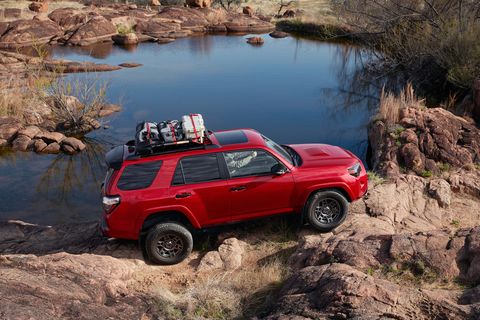Some SUVs just look better when they’re dirty. Not I-parked-it-outside-in-the-rain-last-night dirty. We mean really dirty, with mud splattered over a caked-on layer of trail dust. The special-edition 2020 Toyota 4Runner Venture is one of those SUVs.
Actually, that distinction applies to any Toyota 4Runner. First introduced in 1984, the 4Runner has always been popular with those who enjoy driving beyond the beaten path. Today, it’s one of the closest things there is to a Jeep Wrangler competitor—at least until the new Ford Bronco finally arrives. Although the 4Runner’s current fifth-generation version has been around for a decade, the fact that it hasn’t changed much since its last big facelift in 2014 hasn’t hurt its sales numbers. Toyota sold about 132,000 of them last year.
Ready for Adventure
Based on the 4Runner TRD Off-Road Premium model, the new Venture edition brings the 4Runner’s trim level count to eight. It’s basically an appearance package, featuring the same 17-inch wheels as the 4Runner TRD Pro, as well as black badges, mirror caps, door handles, and a rear spoiler. The Venture’s real draw is the standard Yakima MegaWarrior cargo basket on its roof, which adds considerable functionality and cargo versatility. Inside, Toyota adds all-weather floor mats and a standard rear cargo mat.
All 2020 4Runners get a revised interior with a redesigned instrument cluster, two USB ports, a larger 8.0-inch infotainment touchscreen (up from the previous 6.1-incher), and compatibility with Android Auto, Apple CarPlay, and Amazon Alexa. Toyota’s TSS-P active-safety suite is now standard across the lineup and adds automated emergency braking, lane-departure warning, automatic high-beams, and adaptive cruise control.
Like the Wrangler, the 4Runner’s hardware is old-school SUV stuff. Mostly steel body panels mount to a separate ladder-type frame with a live rear axle. Its underpinnings, including a control-arm front suspension, are similar to those of the Tacoma compact pickup. But the Tacoma’s rear leaf springs are replaced with coils in the SUV for a smoother ride and increased suspension articulation. Most of the 4Runner’s bits are also shared with the Lexus GX460, which shares the Toyota’s 109.8-inch wheelbase.
Most 4Runner models use a part-time four-wheel-drive system with a two-speed low-range transfer case (the Limited and Nightshade get a full-time system with a locking center differential). The Venture also adds a standard locking rear differential, Toyota’s Crawl Control (essentially low-speed off-road cruise control), and the Multi-Terrain Select system, which allows the driver to adjust the drivetrain for different surfaces, including dirt, mud, sand, and rocks. Our test car also came equipped with the optional $1750 Kinetic Dynamic Suspension system, which features hydraulically controlled, two-piece anti-roll bars that can disconnect to further increase suspension articulation off-road and stiffen to minimize body roll on pavement.
Like the TRD Off-Road Premium, the Venture rides on Bridgestone Dueler H/T tires, sized 265/70R-17. They don’t look very aggressive, but they do provide a surprising amount of traction in dry off-road conditions. Out in the wild of Jawbone Canyon, a popular backcountry destination in California’s Mojave desert, the Venture easily climbed steep hills and its 9.6-inches of ground clearance proved to be plenty. However, due to its long rear overhang that affords a modest 26.0-degree departure angle, its back end did scrape the ground more than once.
Softly sprung, the 4Runner’s suspension soaks up all sorts of terrain well and feels relatively plush around town. Undulating washboard surfaces can send some quivers through its structure , but the Venture comfortably bombed though sandy washes at 40 mph without bottoming out.
A Rugged Core
Under its scooped hood, every 4Runner is powered by Toyota’s 4.0-liter V-6 that makes a decent 270 horsepower and 278 pound-feet of torque. But the naturally aspirated V-6’s torque peak doesn’t hit until 4400 rpm, and there isn’t much grunt to be found below 3000 rpm. What really makes the 4Runner feel ancient is its five-speed automatic transmission, which always seems to be in too high of a gear and requires a heavy application of throttle to initiate a kickdown. Despite the Venture’s strong 3.73:1 axle ratios, maintaining 80 mph on mild highway grades usually requires manually selecting fourth gear via the gated shift lever. The aging Lexus GX may have its own vintage qualities, but driving the 4Runner makes us yearn for the additional torque of the Lexus’s 4.7-liter V-8 and the sharper response of its six-speed automatic.
Based on our test of a 2019 TRD Off-Road Premium model, the Venture should hit 60 mph in a reasonable 7.6 seconds and cover the quarter-mile in 15.9 seconds at 88 mph. However, we’d prefer a bit more range in a vehicle designed for overland exploration. Although the 4Runner’s fuel tank is large at 23.0 gallons, we averaged just 14 mpg in the Venture and struggled to milk 300 highway miles from a full tank. The Yakima roof rack—which measures 52.0 inches long, 48 inches wide, and 6.5 inches tall—surely doesn’t help the 4Runner’s aerodynamics on the highway. But at least you could strap a few jerry cans to it for longer treks into the wilderness. Back in Michigan, the 2019 TRD Off-Road version averaged 22 mpg on our 75-mph highway fuel-economy test, which is 2 mpg better than its EPA estimate and good for about 500 miles of range.
Making a Choice
Despite its dated package, the 4Runner’s continued popularity is easy to understand. It is family friendly, ruggedly handsome, and highly capable. A Wrangler Unlimited is better at navigating tight trails, but the larger 4Runner is more spacious and far better behaved on the open road. We expected the roof basket to significantly increase wind noise at higher speeds, but it doesn’t. While the Toyota’s driver’s seat still feels good after eight hours in the saddle, its optional TRD Pro exhaust system drones on the highway and doesn’t enrich the V-6’s voice. Save your $799. The optional $345 running boards also aren’t necessary, as they’re most effective at dirtying the legs of your pants.
At $45,405, the 4Runner Venture isn’t excessively expensive when you consider a well-equipped Wrangler Unlimited can top $60K, but its value is questionable. We appreciate its breadth of features and capability, yet it delivers the same interior amenities, driving experience, and off-road capability as the TRD Off-Road Premium model, which costs $1815 less. Frugal buyers can bolt on a MegaWarrior cargo basket themselves for $449.
You can also get the Venture’s off-road hardware on the TRD Off-Road model and save about $4000. Conversely, we’d rather spend $1258 more than our example’s $49,727 as-tested price for the full TRD Pro model, which remains the most off-road capable 4Runner you can buy. Whichever version you choose, just make sure to get it dirty.
This content is created and maintained by a third party, and imported onto this page to help users provide their email addresses. You may be able to find more information about this and similar content at piano.io
This commenting section is created and maintained by a third party, and imported onto this page. You may be able to find more information on their web site.




![2023 TGR Dakar Team Announced [w/video] 2023 TGR Dakar Team Announced [w/video]](https://img.freepik.com/free-photo/motocross-rider-action-motocross-sport_654080-1649.jpg?ga=GA1.1.2045282162.1728623127&semt=ais_hybrid)
